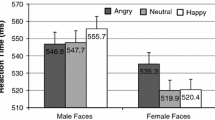Abstract
The current studies were designed to examine the influence of apparent gender on the interpretation of ambiguous emotional expressions. Participants rated the intensity of emotions that were expressed in two versions of the same emotional expression, in which hair style and clothing were altered to manipulate gender. The emotional expression in each of the photos was a combination of anger and sadness. Of interest was the effect of the apparent gender of the poser on the interpretation of the blended emotional expression. In Study 2 we also examined whether the social role (i.e., occupation) of the poser influenced the interpretation. Although the occupation of the poser did not influence emotion ratings, the apparent gender of the poser influenced the interpretation of ambiguous emotional expressions in a stereotype-consistent manner in both Studies 1 and 2.
Similar content being viewed by others
REFERENCES
Algoe, S. B., Buswell, B. N., & DeLamater, J. D. (2000). Gender and job status as contextual cues for the interpretation of facial expression of emotion.Sex Roles, 42 ,183–208.
Brody, L. R. (1999). Gender, emotion, and the family.Cambridge, MA: Harvard University Press.
Brody, L. R., & Hall, J. A. (1993). Gender and emotion. In M. Lewis & J. M. Haviland (Eds.), Handbook of emotions (pp. 447–460). New York: Guilford Press.
Condry, J., & Condry, S. (1976). Sex differences: A study of the eye of the beholder. Child Development, 47 ,812–819.
Conway, M., Di Fazio, R., & Mayman, S. (1999). Judging others' emotions as a function of the others' status. Social Psychology Quarterly, 62, 291–305.
Darley, J. M., & Fazio, R. H. (1980). Expectancy confirmation processes arising in the social interaction sequence.American Psychologist, 35 ,867–881.
Eagly, A. H., & Steffen, V. J. (1984). Gender stereotypes stem from the distribution of women and men into social roles. Journal of Personality and Social Psychology, 46 ,735–754.
Eagly, A. H., & Wood, W. (1999). The origins of sex differences in human behavior: Evolved dispositions versus social roles.American Psychologist, 54 ,408–423.
Ekman, P., & Friesen, W. V. (1978). Facial action coding system: A technique for measurement of facial movement.Palo Alto, CA: Consulting Psychologist Press.
Fabes, R. A., & Martin, C. L. (1991). Gender and age stereotypes of emotionality. Personality and Social Psychology Bulletin, 17 ,532–540.
Fischer, A. H. ( Ed.). (2000). Gender and emotion: Social psychological perspectives. Cambridge, UK: Cambridge University Press.
Fischer, A. H., & Manstead, A. S. R. (2000). The relation between gender and emotion in different cultures. In A. H. Fischer (Ed.), Gender and emotion: Social psychological perspectives(pp. 71–96). Cambridge, UK: Cambridge University Press.
Fiske, S. T. (1993). Controlling other people: The impact of power on stereotyping. American Psychologist, 48, 621–628.
Grossman, M., & Wood, W. (1993). Sex differences in intensity of emotional experience: A social role interpretation. Journal of Personality and Social Psychology, 65 ,1010–1022.
Hess, U., Senecal, S., Kirouac, G., Herrera, P., Philippot, P., & Kleck, R. (2000). Emotional expressivity in men and women: Stereotypes and self-perceptions. Cognition and Emotion, 14 ,609–642.
Hutson-Comeaux, S. L., & Kelly, J. R. (2002). Gender stereotypes of emotional reactions: How we judge an emotion as valid. Sex Roles, 47 ,1–10.
Johnson, J. T., & Shulman, G. A. (1988). More alike than meets the eye: Perceived gender differences in subjective experience and its display. Sex Roles, 19 ,67–79.
Plant, E. A., Hyde, J. S., Keltner, D., & Devine, P. G. (2000). The gender stereotyping of emotions. Psychology of Women Quarterly, 24 ,81–92.
Robinson, M. D., Johnson, J. T., & Shields, S. A. (1998). The gender heuristic and the database: Factors affecting the perception of gender-related differences in the experience and display of emotions. Basic and Applied Social Psychology, 20 ,206–219.
Roseman, I. J., Wiest, C., & Swartz, T. S. (1994). Phenomenology, behaviors, and goals differentiate discrete emotions. Journal of Personality and Social Psychology, 67 ,206–221.
Rosenkrantz, P., Vogel, S., Bee, H., Broverman, I., & Broverman, D. M. (1968). Sex-role stereotypes and self-concepts in college students. Journal of Consulting and Clinical Psychology, 32 ,287–295.
Ruble, T. L. (1983). Sex stereotypes: Issues of change in the 1970s. Sex Roles, 9 ,397–402.
Shields, S. A. (1987). Women, men, and the dilemma of emotion. In P. Shaver & C. Hendrick (Eds.), Sex and gender (pp. 229–250). Thousand Oaks, CA: Sage.
Shields, S. A. (2002). Speaking from the heart: Gender and the social meaning of emotion. Cambridge, UK: Cambridge University Press.
Smith, K. C., Ulch, S., Cameron, J., Cumberland, J., Musgrave, M., & Tremblay, N. (1989). Gender-related effects in the perception of anger expression. Sex Roles, 20 ,487–499.
Snodgrass, S. E. (1985). Women's intuition: The effect of subordinate role on interpersonal sensitivity. Journal of Personality and Social Psychology, 49 ,146–155.
Snodgrass, S. E. (1992). Further effects of role versus gender on interpersonal sensitivity. Journal of Personality and Social Psychology, 62 ,154–158.
Tiedens, L. Z., Ellsworth, P. C., & Mesquita, B. (2000). Stereotypes about sentiments and status: Emotional expectations for high-and low-status group members. Personality and Social Psychology Bulletin, 26 ,560–574.
U.S. Department of Labor, Bureau of Labor Statistics. (2001). Labor force statistics from the current population survey (Table 11) [Data File]. Available from http://www.bls.gov/cps/#tables
Widen, S. C., & Russell, J. A. (2002). Gender and preschoolers' perception of emotion. Merrill-Palmer Quarterly, 48 ,248–262.
Williams, J. E., & Best, D. L. (1990). Measuring sex stereotypes: A multination study.Newbury Park, CA: Sage.
Author information
Authors and Affiliations
Rights and permissions
About this article
Cite this article
Plant, E.A., Kling, K.C. & Smith, G.L. The Influence of Gender and Social Role on the Interpretation of Facial Expressions. Sex Roles 51, 187–196 (2004). https://doi.org/10.1023/B:SERS.0000037762.10349.13
Issue Date:
DOI: https://doi.org/10.1023/B:SERS.0000037762.10349.13




